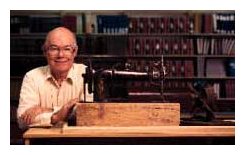|
This collection of valuable nineteenth century patent models, dating from 1842 to 1883, is the generous gift of Homer and Jean Blair.
Before the revision of the U. S. Patent law in 1870, inventors seeking a patent for a mechanical device were required to submit with their applications, a model as well as drawings and written descriptions. Models are now required only when the Patent Office feels that the applicant must prove the invention works.
Many models were destroyed in two disastrous fires in the Patent Office, in 1836 and again in 1877, but thousands have survived. At least two items in this collection were rescued from the ashes of the fire of 1877.
-
Carpet Sweepers, U. S. Patent 199,612, July 29, 1878, Melville R. Bissell, Grand Rapids, Michigan.
-
Coating Articles with Celluloid, etc., U. S. Patent 202,441, April 16, 1878, John W. Hyatt, Newark, New Jersey
-
Expanding Drums for Paper-Cutting Machines, U. S. Patent 203,833, May 21, 1878,William E. Hudson, North Manchester, Connecticut.
-
Button-Hole Cutter, U. S. Patent 222,080, November 25, 1879, Moses L. Sanborn and Gideon M. Sanborn, Denmark, Maine.
-
Automatic Gate Latch, U. S. Patent 226,577, April 13, 1880, Albert F. Webb and John L. Duncan, Franklin, Indiana.
-
Gas-Carbureter (Apparatus for carburating or enriching common illuminating gas), U. S. Patent 226,820, April 20, 1880, Henry J. Ferguson, New York, New York
-
Hollow Stem Lamp, U. S. Patent 249,676, November 15, 1881, Daniel C. Ripley, Pittsburgh, Pennsylvania
-
Dye-Stuff, U. S. Patent 251,163, December 20, 1881, Henrich Baum, Horchst-on-the-Main, Germany, Assignor to Farbwerke, Vormals (formerly) Meister Lucius & Bruning.
-
Wicket (Ticket Window), U. S. 270,309, January 9, 1883, M. La Rue Harrison and Franklin Underhill, Washington, DC and Stamford Connecticut.
-
Elias Howe Sewing Machine containing Model number "8", an invention that was an improvement to the sewing machine.
|

-
Stove, U. S. Patent 2,566, April 16, 1842, Salvin F. Kellogg, Norwalk, Ohio.
-
Grain Drier, U. S. Patent 4,777, September 26, 1846, Sebre Howard, Adrian, Michigan.
-
Machine for Upsetting (clamping) Tires (wagon), U. S. Patent 16,331, January 6, 1857, Russell W. Gates, Homer, Michigan.
-
Sewing Machine, U. S. Patent 22,143, November 23, 1858, Hiram W. Harkness, Bristol, Connecticut.
-
Coal Stove, U. S. Patent 41,430, February 2, 1864, William H. Goewey, Albany, N.Y.
-
Magic Lantern, U. S. Patent 42,412, April 19,1864, George Sibbald, Philadelphia, Pennsylvania.
-
Straight Knitting Machine, U. S. Patent 55,420, June 5, 1866, Rev. M.T. Lamb, Valparaiso, Indiana.
-
Sewing Machine, U. S. Patent 63,483, April 2, 1867, George S. Darling and Elias Howe, Jr., Bridgeport and Fairfield, Connecticut.
-
Tea Kettle and Other vessels, U. S. Patent 67,425, August 6, 1867, Sheldon B. Everitt,Ansonia, Connecticut.
-
Sad-Iron Heater, U. S. Patent 70,572, November 5, 1867, George Hurdman, Wolverhampton, England.
-
Heating Drum (Heat Regulator), U. S. Patent 76,564, April 7, 1868, Jacob Voegtle, Indianapolis, Indiana.
-
Magazine Stove, U. S. Patent 86,940, February 16, 1869, John S. Perry, Albany, New York.
-
Sewing Machine, U. S. Patent 113,407, April 4, 1871, Alfred S. Dinsmore, Boston, Massachusetts.
-
Sad Iron, U. S. Patent 113,448, April 4, 1871, Mary Florence Potts, Ottumwa, Iowa
-
Spool for Boot and Shoe Soling Machines, U. S. Patent 143,137, September 23, 1873, Louis Goddu.
-
Profiling Machines, U. S. Patent, 150,253, April 28, 1874, Edward G. Parkhurst, Hartford, Connecticut.
-
Reversable Sad-Iron, U. S. Patent 166,421, August 3, 1875, Thomas T. Smothers, Bryan, Texas.
-
Barb-Former (for barbed wire),U. S. Patent 179,625, July 4, 1876 ( United States Centennial date), James A. Swan, Joliet, Illinois.
-
Barbed Wire Pincher, U. S. Patent 180,351, July 25, 1876, Charles Kennedy, Hinckley, Illinois.
|